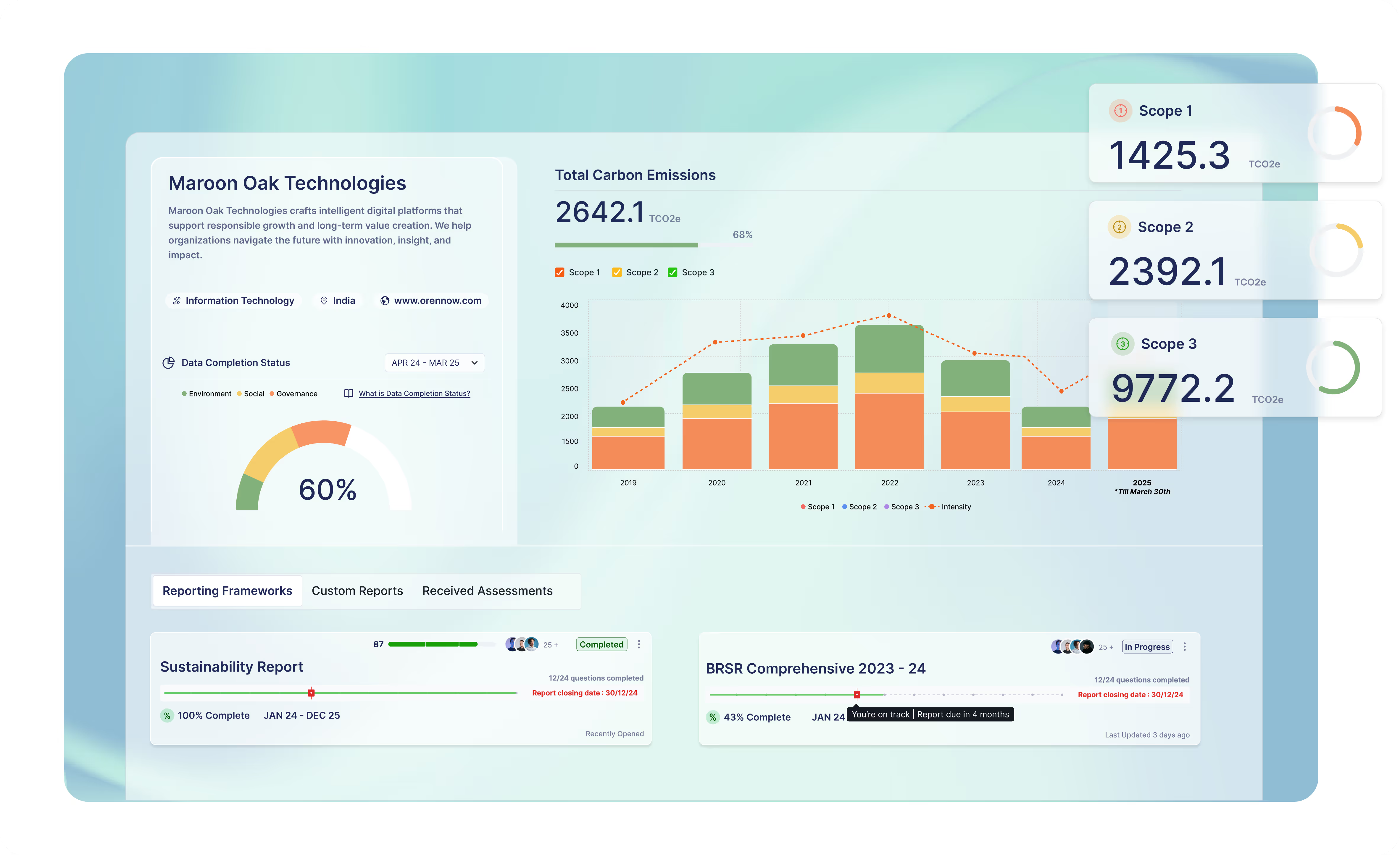Ensuring ESG Audit & Assurance Readiness: A Guide for Sustainability Leaders
.webp)
Introduction to ESG Audit: Definition, Purpose, and Scope
An ESG audit is a structured evaluation of a company’s Environmental, Social, and Governance practices. Unlike traditional audits, ESG audits look at how operations affect the planet, people, and governance structure.
It covers:
- The issues that are being evaluated
- The periods or time frames being studied, i.e., when the assessment is being carried out
- The methodology, i.e, how the audit will be conducted
As regulatory and investor pressures mount, readiness matters. According to recent research by KPMG, only 29% of companies globally currently feel prepared to have their ESG data independently assured. This gap highlights the importance of proactive audit readiness: without it, organisations risk inaccuracies, compliance challenges, and weakened stakeholder confidence.
The core purpose of ESG readiness is to identify risks, validate data, and ensure that disclosures are accurate. It is also about being certain of the alignment with frameworks such as India’s Business Responsibility and Sustainability Reporting (BRSR) or global standards like the Global Reporting Initiative (GRI). By embedding ESG audits into regular governance processes, companies strengthen transparency, improve decision-making, and maintain trust with investors, regulators, and other stakeholders.
This guide offers sustainability leaders actionable steps to ensure that their companies are audit-ready.
Why Audit Readiness is Crucial for Credible ESG Reporting
Audit readiness is more than ticking compliance boxes. It is about making sure that ESG disclosures are accurate, verifiable, and actionable. With frameworks like India’s BRSR mandating assurance for the top 150 listed companies by FY 2023-2024 and extending to the top 1000 by FY 2026-27, organisations must be able to demonstrate that their environmental, social, and governance metrics are grounded in evidence. In practice, ESG readiness empowers sustainability leaders to:
- Anticipate regulatory changes
- Streamline documentation
- Validate claims across operations and supply chains.
Being audit-ready helps companies:
- Identify gaps in reporting
- Mitigate ESG-related risks
- Align internal processes with global standards such as GRI, SASB, or CSRD
It also strengthens transparency and enables stakeholders to trust the data behind sustainability claims. Studies show that Indian firms increasingly recognise this, and over 50% of the top 100 listed companies voluntarily disclosed Scope 3 emissions in FY23. This signals a growing commitment to robust ESG reporting.
Key Steps to Achieve ESG Audit & Assurance Readiness
To build a defensible, auditable foundation before any external scrutiny and turn ESG audits into a source of credibility and strategic advantage, organisations should consider the following key steps:
1. Define Material ESG Metrics and Frameworks
- Begin by selecting the right reporting frameworks (e.g., Global Reporting Initiative (GRI), Sustainability Accounting Standards Board (SASB), or regional standards).
- Then, identify material ESG issues relevant to your business. It can be environmental (energy use, emissions, waste), social (labour conditions, diversity, community impact), or governance (board structure, ethics, compliance).
- Metrics should be specific, measurable and aligned with business strategy so reporting is meaningful and comparable.
2. Centralise Data Collection and Documentation
Use a robust, organisation-wide ESG data system to centralise information from operations, HR, procurement, finance, and compliance. Store all supporting documents in a traceable repository to stay audit-ready at any time. These can be from energy logs to details like board minutes.
Adopt ESG-reporting technology to automate data validation, ensure traceability, and maintain clear audit trails. These tools reduce errors, accelerate audits, and are especially valuable for large organisations with complex supply chains.
3. Establish Strong Internal Controls & Governance Structure
Set up an ESG‑governance framework with clear accountability. Define roles from top leadership to operational teams. Implement internal controls (checks and balances), regular data validation and review protocols to ensure alignment of data accuracy, consistency and integrity. This prevents errors, omissions or ‘greenwashing’ when disclosures are audited.
4. Conduct Periodic Internal Audits and Gap Assessments
Treat ESG akin to financial reporting: run internal audits or mock audits before external assurance. These assessments should test data, controls, reporting processes, and compliance with chosen frameworks. Internal audit teams help in highlighting weaknesses early. They assist by suggesting corrective actions and preparing the ground for a smooth external audit.
5. Engage Stakeholders & Map Materiality Continuously
Engage internal and external stakeholders, including employees, suppliers, investors, and communities. There can be consultations, workshops or surveys. Use stakeholder input to periodically reassess what is material to the business and its stakeholders. This brings in relevance, builds trust, and helps align ESG reporting with stakeholder expectations.
6. Implement Continuous Improvement & Training Culture
ESG audit readiness is not a one‑time event. Companies should regularly review and update their ESG policies, controls, and reporting processes. This helps reflect on evolving standards, regulatory changes, and stakeholder expectations. Training programmes, across all relevant departments, make sure everyone understands their role in ESG governance and audit preparedness.
Benefits of Being Audit-Ready: Building Trust, Compliance, and Business Value
ESG readiness ensures compliance and also offers several strategic advantages:
- Enhanced Compliance: Companies can more easily meet the stringent requirements of regulators like BRSR and CSRD. This makes sure their reporting is always up to standard.
- Operational Efficiency: Streamlined data management cuts costs and saves time.
- Risk Mitigation: Accurate reporting lowers regulatory and reputational risks.
- Increased Investment Opportunities: Transparent ESG practices attract investors and capital.
- Better Market Advantage: This is possible by differentiating themselves from their peers and demonstrating a commitment to high environmental and social standards.
- Strengthened Stakeholder Trust: Clear reporting builds trust and improves stakeholder relationships.
Emerging Trends and Technologies Shaping ESG Audit Readiness
The growing complexity of ESG audits makes technology intervention in ESG readiness essential. Here’s what’s getting adopted:
- AI & Machine Learning: Automates data collection and anomaly detection. Also, predictive ESG risk analysis helps forecast ESG risks, carbon exposure, and regulatory impacts.
- NLP & Automated Report Parsing: Extracts ESG data from unstructured sources and flags inconsistencies.
- Blockchain: Ensures tamper-proof records for supply chains, emissions, and sustainability claims.
- Sensor Monitoring: Provides real-time environmental data on energy, emissions, and waste.
- Cloud-Based ESG Platforms: Centralise data, audit trails, and reporting across departments.
- Audit Workflow & Collaboration Tools: Standardise audit steps, track evidence via automated request lists, and secure document management.
Conclusion: Making ESG Audit Readiness an Integral Part of Your Sustainability Strategy
Maintaining ESG audit readiness is essential for credible, transparent sustainability reporting. By defining clear metrics, centralising data, and fostering continuous improvement, companies can meet compliance requirements and strengthen stakeholder trust.
With Oren, organisations can be worry-free when it comes to centralising ESG data collection, validating metrics, and streamlining processes across departments. In other words, we make audit readiness achievable without adding operational complexity. Get ready to navigate evolving regulations and drive long-term ESG success now!
FAQs
1. What distinguishes an ESG audit from financial audits?
ESG audits verify ESG disclosures and benchmark against standards like GRI or SASB, while financial audits focus solely on monetary data and regulatory compliance.
2. How can SMEs prepare effectively for ESG audits without large resources?
SMEs can prepare for ESG audits by prioritising material ESG risks, centralising data using simple digital tools, aligning with frameworks like GRI/SASB, conducting internal reviews, training employees, and maintaining clear documentation. These steps ensure credibility and compliance without a large resource investment.
3. What are the main differences between an ESG audit and assurance?
An ESG audit involves evaluating a company’s environmental, social, and governance practices. It also includes verifying data and identifying risks. ESG Assurance goes further by providing an independent, third-party validation of ESG disclosures. It confirms accuracy, reliability, and compliance with reporting standards like GRI or SASB.
4. How often should ESG audits and assurance reviews be conducted?
ESG audits and assurance reviews are typically conducted on an annual basis. It is in alignment with financial reporting cycles. However, many companies are adopting more frequent internal reviews, such as quarterly pulse checks.
Latest Blog Posts
Dive into our blog for insights on making your organization more sustainable.
Sustainability Simplified
Wherever you are in your sustainability journey, we help you advance with confidence.
Schedule a Call



.avif)

